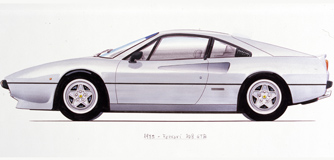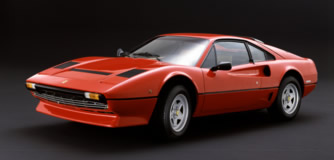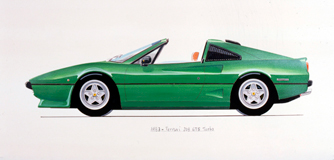|
The Pininfarina designed body had a pronounced wedge profile, with a rectangular egg-crate aluminium radiator grille below a slim full width satin black front bumper.
A square section indent line ran along
each body side between the front and rear bumpers, which was finished in satin black whatever the main body colour. The doors featured scalloped intakes to the engine bay, the right one feeding the carburettor filter box, and
the left one the oil cooler. On the 208 GTS the rear quarter windows behind the doors were hidden behind hinged louvre panels, the left one giving access to the fuel filler cap. The only visual difference between the 208 GTS
and the 208 GTB, was the black grained finish removable roof panel of the former, which was stowed in a cover behind the seats when not in place. At the rear there were twin circular light assemblies on the vertical recessed
tail panel. A single piece lid hinged at the roof covered the engine bay and boot, and the vertical concave rear screen was bounded by buttressed sail panels. Options available were wider 7.5" rims, air conditioning, a radio, a
deeper front spoiler, plus Michelin TRX or Pirelli P Zero tyres on special rims.
As with the exterior the interior was virtually identical to the larger capacity 308 GTS model, featuring a pair of leather trimmed bucket
seats, whilst the main instruments were contained in a hooded nacelle in front of the driver, who was provided with a three spoke leather rimmed steering wheel. The clock and oil temperature gauge were mounted in a separate
panel on the lower left edge of the dashboard. The gear lever in an open gate was mounted in the driver's side of the centre console, which also contained ancillary switchgear, the handbrake and an ashtray.
The 208 GTS
models had a tubular chassis with factory type reference F 106 CS 100. Disc brakes, with independent suspension via wishbones, coil springs, and hydraulic shock absorbers, were provided all round, with front and rear anti roll
bars. All models were numbered in the Ferrari odd number road car chassis sequence, with only left hand drive available. Production ran from 1980 through to 1982, during which time 140 examples were produced in the chassis
number range 31249 to 41265.
The transversely mid-mounted aluminium V8 engine was essentially of the same design as that used in the 308 GTS model. It was of a 90 degree configuration, with belt driven twin overhead
camshafts per bank, having a total capacity of 1991cc, with a bore and stroke of 66.8mm x 71mm, bearing factory type reference F 106 CB 000. The engine was coupled in unit with the all synchromesh five speed transmission
assembly, which was below, and to the rear of the engine's sump. It was fitted with a bank of four twin choke Weber 34 DCNF carburettors, mounted in the centre of the vee, and had a claimed power output of 155bhp at 6800rpm
- 208 Model Specification
Engine
Type...............................rear, transverse, 90° V8
Bore/stroke......................66.8 x 71 mm
Unitary displacement..........248.83 cc
Total displacement............1990.64 cc
Compression ratio..............9 : 1
Maximum power................114 kW (155 hp) at 6800 rpm
Power per litre..................78 CV/l
Maximum torque...............170 Nm (17.3 kgm) at 4200 rpm
Valve actuation.................twin overhead camshafts per bank, two valves per cylinder
Fuel feed.........................four Weber 34 DCNF carburettors
Ignition...........................single spark plug per cylinder, single coil
Lubrication.......................wet sump
Clutch.............................single-plate
Chassis
Frame.............................tubular steel
Front/Rear suspension........independent, unequal-length wishbones,
coil springs over telescopic shock absorbers,
anti-roll bar
Brakes.............................discs
Transmission....................5-speed + reverse
Steering..........................rack-and-pinion
Fuel tank.........................capacity 74 litres
Front tyres.......................205/70 VR 14
Rear tyres........................205/70 VR 14
Bodywork
Type...............................two-seater berlinetta or two-seater targa-top
Length............................4230 mm
Width.............................1720 mm
Height.............................1120 mm
Wheelbase.......................2340 mm
Front track......................1460 mm
Rear track.......................1460 mm
Weight............................1232 kg (dry) GTB
1254 kg (dry) GTS
Performance
Top speed........................215 km/h
|



